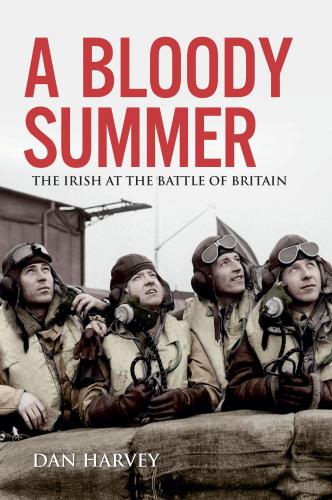From a family with deep roots in Moville, County Donegal, General Montgomery was a professional and very serious-minded soldier who had seen service in the First World War, where he was decorated (DSO), and shot and left for dead. He returned after the war, determined that the army could do better, only to be posted to ‘Rebel Cork’; during the War of Independence (1919–21) as Brigade Major of the 17th Infantry Brigade stationed in Victoria Barracks (now Collins Barracks) where he considered the conducting of operations to be worse than in the Great War. He felt that the vicious IRA ambushes, Black and Tans reprisals and Auxiliary assassinations ‘lowered their standards of decency and chivalry’ and was happy when the truce came. At the outbreak of the Second World War he commanded a division in France, prior to Dunkirk, and was among the last of the BEF – over 225,000 men – to be brought back across the English Channel.
The last of the BEF were successfully evacuated on 4 June 1940, leaving the Axis Powers in control of the European continent and poised to invade England and Ireland. The Germans took a self-assured halt to regroup after their highly successful race towards the northern French coastline. Here they instituted an operational pause to consolidate their now heavily extended supply lines and plan for the invasion of southern England and Ireland.
Hitler hoped that Britain would seek an armistice, an agreement not to fight. Capitulation, a blockade, bombardment with massive coastal guns or bombing – these were all possible means by which he could avoid having to invade England.
If the early campaign (despite the series of rapid victories) had taken its toll on German forces, the British had received a massive mauling and needed time to reorganise; they needed to draw breath and, more significantly, halt any defeatist attitude that the Germans were invincible.
Young, competent leadership needed to be encouraged and introduced into the command structures. There was a sense of urgency in the need to mount a meaningful defence; the army needed, instead of being left to ‘lick its wounds’, to train hard in order to fight.
Britain had a powerful navy and a modern, rapidly expanding air force. What’s more, the RAF managed to develop its strength during the Phoney War – the lull between Britain and France’s declaration of war on 3 September 1939 and the invasion of the Low Countries and France, beginning 10 May 1940. It had, however, lost pilots and aircraft during the Battle of France and so also needed to re-equip its squadrons. Despite this, all in all, the RAF was in reasonable to good shape with 640 serviceable aircraft and 1,103 trained pilots.
In June 1940, via intercepted communications, the British became aware of the possibility of not only a planned German invasion of England, but also the possibility of a German invasion of Ireland. This risked exposing their western flank. Control of Ireland’s landmass and valuable ports (Cork, Castletownbere and Lough Swilly) would act as a boon for a German invasion of Britain and would also extend Germany’s range over the Atlantic. This potential was perilous to British interests, and so demanded a swift and robust response. In order to better safeguard their defences, they had to either forcefully take control of the Republic of Ireland, or seek its cooperation in countering the threat. The latter course of action was chosen.
This involvement was controversial given the Republic’s policy of neutrality and the fact that its independence from Britain was only recently won through force of arms – members of Irish government had been combatants in the revolutionary period. But an agreement was reached and joint military operations were planned in the event of invasion by Nazi Germany. Plan W, as it became known, was very far out of keeping with the strict notion of neutrality – it necessitated rigorous impartiality, or else the neutral rights were forfeit. It has been said that Ireland was neutral during the Second World War, only that it was ‘neutral on the side of the Allies’ or ‘neutral against Germany’; they returned downed Allied airmen, exchanged intelligence and supplied weather reports ahead of the D-Day landings. So it was very much an ‘Irish neutrality’ – a highly nuanced neutrality, and one not really in keeping with the exact spirit and ideology of what it meant to be neutral proper. It was practical, pragmatic and flexible; an Irish solution to an Irish problem.
Operationally, Plan W centred on Northern Ireland serving as a base for a new BEF which would cross the border to engage with and repel any German invasion force. The British 53rd (Welsh) Division in Belfast would be the designated strike force, manoeuvring by road and rail. Simultaneously, the 61st Division, in a separate operation, would move into County Donegal, securing Lough Swilly for the Royal Navy. The Royal Marines at Milford Haven would provide a brigade at Wexford as a bridgehead for further operations.
German amphibious landings were likely to target Cork, as it was the nearest landfall between Luftwaffe bases in north-western France and Ireland; however, Limerick, Waterford, Westport, Galway, Sligo and Donegal were not to be excluded, and German paratrooper drops and seaplane-borne landings in lakes were also likely.
Конец ознакомительного фрагмента.
Текст предоставлен ООО «ЛитРес».
Прочитайте эту книгу целиком, купив полную легальную версию на ЛитРес.
Безопасно оплатить книгу можно банковской картой Visa, MasterCard, Maestro, со счета мобильного телефона, с платежного терминала, в салоне МТС или Связной, через PayPal, WebMoney, Яндекс.Деньги, QIWI Кошелек, бонусными картами или другим удобным Вам способом.
